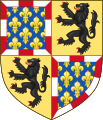House of Valois-Burgundy
| House of Valois-Burgundy | |
|---|---|
France | |
| Founded | 6 September 1363 |
| Founder | Philip the Bold |
| Final ruler | Mary of Burgundy |
| Titles | List
|
| Estate(s) | Palace of the Dukes |
| Dissolution | 23 March 1500[1] |
The House of Valois-Burgundy (French: Maison de Valois-Bourgogne, Dutch: Huis van Valois-Bourgondië), or the Younger House of Burgundy, was a noble French family deriving from the royal House of Valois. (It is distinct from the Capetian House of Burgundy, descendants of King Robert II of France, though both houses stem from the Capetian dynasty.) The Valois-Burgundy family ruled the Duchy of Burgundy from 1363 to 1482 and eventually came to rule vast lands including Artois, Flanders, Luxembourg, Hainault, the county palatine of Burgundy (Franche-Comté), and other lands through marriage, forming what is now known as the Burgundian State.
The term "Valois Dukes of Burgundy" is employed to refer to the dynasty which began after King John II of France granted the French Duchy of Burgundy to his youngest son, Philip the Bold in 1363.
During the
History
The former Frankish
The Capetian House of Burgundy became extinct when Duke Philip I died in 1361, before he was able to consummate the marriage with Margaret of Dampierre, heiress of Count Louis II of Flanders. The Duchy of Burgundy was then unified with the French royal domain under the Valois king John II. Soon after, however, John's fourth son Philip the Bold received the Duchy of Burgundy as an appanage from the hands of his father.

Philip the Bold ruled as Duke Philip II of Burgundy from 1363 to 1404. In 1369 he himself married the widowed Margaret of Dampierre, and when his father-in-law Count Louis II of Flanders died in 1384, he succeeded him not only in the French counties of
Raised in Flanders, Duke John the Fearless succeeded his father in 1404 and unified the heritage of his mother Margaret of Dampierre with the Burgundian duchy. Ceding the French counties of Nevers and Rethel to his younger brothers

John's son
The Valois-Burgundy duke
The Burgundian heritage eventually passed to the Habsburg archduke Maximilian, who married Mary of Burgundy seven months after her father's death and could ward off the claims raised by King
Dukes of Burgundy (1363–1482)
| Dukes of Burgundy | |||
|---|---|---|---|
| House of Valois-Burgundy | |||
| Image | Name | Date | Notes |
 |
Philip the Bold | 1363–1404 | Fourth son of King Bonne of Luxembourg. Married Countess Margaret III of Flanders in 1369.
|
 |
John the Fearless | 1404–1419 | First-born son of Philip the Bold. United the heritage of his mother with Burgundy. Married Margaret of Bavaria in 1385. |
 |
Philip the Good | 1419–1467 | First-born son of John the Fearless. Acquired most of the Burgundian Netherlands. |
 |
Charles the Bold | 1467–1477 | Only legitimate heir of Philip the Good and his third wife Isabella of Portugal. Last Valois duke of Burgundy, killed in the Battle of Nancy. |
 |
Mary | 1477–1482 | Only child of Charles the Bold and his second wife Isabella of Bourbon, married the Habsburg archduke Maximilian I of Austria in 1477. |
Coats of Arms
See: Coats of Arms of the 2nd House of Burgundy
Category:Coats of arms of the Duchy of Burgundy
-
Philippe the Bold, as count of Touraine
-
Philippe the Bold, as duke of Burgundy
-
Jean the Fearless, duke of Burgundy
-
Philippe the Good and Charles the Bold, as dukes of Burgundy
-
Charles the Bold, as count of Charolais
-
Corneille and Antoine the Grand Bastard
-
Antoine and Philipe, dukes of Brabant
-
Philippe, as count of Saint Pol
-
Philippe, count of Nevers
See also
- History of Burgundy
- Burgundian State
- Genealogy of the 2nd House of Burgundy
- Genealogy of Dukes of Burgundy
- Passport to Pimlico
References
- ^ Boltanski, Ariane (2006). es ducs de Nevers et l'État royal: genèse d'un compromis (ca 1550 - ca 1600). Librairie Droz S.A. p. 501.
- ^ Although, the Burgundian state passed to Mary the Rich, the last male representative of the House of Valois-Burgundy was actually a grandson of Philip the Bold, John II, Count of Nevers (20 October 1415 – 25 September 1491), and the last legitimate male-line descendant of the house was his second daughter, Charlotte, Countess of Rethel (c. 1472 – 23 August 1500), wife of Jean d'Albret, Sire of Orval, and mother of Marie d'Albret, Countess of Rethel (see Boltanski 2006).










